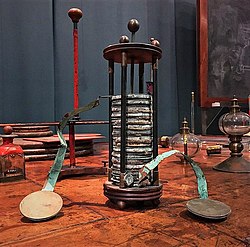Voltaic pile
Voltaic Pile[edit]

The Voltaic Pile was the first electrical battery that could continuously provide an electric current to a circuit. It was invented by Alessandro Volta in 1800 and marked a significant milestone in the field of electricity.
History[edit]
The invention of the Voltaic Pile was a result of Volta's experiments with galvanic cells. Volta's work was inspired by the earlier experiments of Luigi Galvani, who discovered that the muscles of dead frogs twitched when struck by a spark of electricity. Volta hypothesized that the twitching was caused by an electrical current generated by the contact of two different metals in a moist environment.
Construction[edit]
The Voltaic Pile consists of a series of discs made of two different types of metals, typically copper and zinc, separated by pieces of cardboard or cloth soaked in saltwater or acid. The metals act as electrodes, and the saltwater or acid acts as the electrolyte. When the metals are stacked in an alternating sequence, they create a series of galvanic cells connected in series, which produces a steady electric current.
Operation[edit]
The operation of the Voltaic Pile is based on the electrochemical reaction between the metals and the electrolyte. The zinc disc undergoes oxidation, releasing electrons, while the copper disc undergoes reduction, accepting electrons. This flow of electrons from the zinc to the copper through an external circuit constitutes an electric current.
Impact[edit]
The invention of the Voltaic Pile had a profound impact on the study of electricity and chemistry. It provided scientists with a reliable source of electric current, enabling further experiments and discoveries. The Voltaic Pile led to the development of electrochemistry and the discovery of new elements through electrolysis.
Legacy[edit]
The principles behind the Voltaic Pile are still used in modern batteries, although contemporary designs have evolved significantly. The Voltaic Pile is considered a precursor to modern electrochemical cells and remains an important historical artifact in the study of electricity.
Related pages[edit]
Ad. Transform your life with W8MD's Budget GLP-1 injections from $75


W8MD offers a medical weight loss program to lose weight in Philadelphia. Our physician-supervised medical weight loss provides:
- Weight loss injections in NYC (generic and brand names):
- Zepbound / Mounjaro, Wegovy / Ozempic, Saxenda
- Most insurances accepted or discounted self-pay rates. We will obtain insurance prior authorizations if needed.
- Generic GLP1 weight loss injections from $75 for the starting dose.
- Also offer prescription weight loss medications including Phentermine, Qsymia, Diethylpropion, Contrave etc.
NYC weight loss doctor appointmentsNYC weight loss doctor appointments
Start your NYC weight loss journey today at our NYC medical weight loss and Philadelphia medical weight loss clinics.
- Call 718-946-5500 to lose weight in NYC or for medical weight loss in Philadelphia 215-676-2334.
- Tags:NYC medical weight loss, Philadelphia lose weight Zepbound NYC, Budget GLP1 weight loss injections, Wegovy Philadelphia, Wegovy NYC, Philadelphia medical weight loss, Brookly weight loss and Wegovy NYC
|
WikiMD's Wellness Encyclopedia |
| Let Food Be Thy Medicine Medicine Thy Food - Hippocrates |
Medical Disclaimer: WikiMD is not a substitute for professional medical advice. The information on WikiMD is provided as an information resource only, may be incorrect, outdated or misleading, and is not to be used or relied on for any diagnostic or treatment purposes. Please consult your health care provider before making any healthcare decisions or for guidance about a specific medical condition. WikiMD expressly disclaims responsibility, and shall have no liability, for any damages, loss, injury, or liability whatsoever suffered as a result of your reliance on the information contained in this site. By visiting this site you agree to the foregoing terms and conditions, which may from time to time be changed or supplemented by WikiMD. If you do not agree to the foregoing terms and conditions, you should not enter or use this site. See full disclaimer.
Credits:Most images are courtesy of Wikimedia commons, and templates, categories Wikipedia, licensed under CC BY SA or similar.
Translate this page: - East Asian
中文,
日本,
한국어,
South Asian
हिन्दी,
தமிழ்,
తెలుగు,
Urdu,
ಕನ್ನಡ,
Southeast Asian
Indonesian,
Vietnamese,
Thai,
မြန်မာဘာသာ,
বাংলা
European
español,
Deutsch,
français,
Greek,
português do Brasil,
polski,
română,
русский,
Nederlands,
norsk,
svenska,
suomi,
Italian
Middle Eastern & African
عربى,
Turkish,
Persian,
Hebrew,
Afrikaans,
isiZulu,
Kiswahili,
Other
Bulgarian,
Hungarian,
Czech,
Swedish,
മലയാളം,
मराठी,
ਪੰਜਾਬੀ,
ગુજરાતી,
Portuguese,
Ukrainian